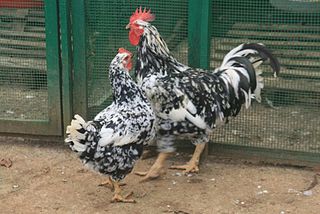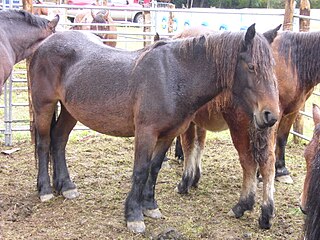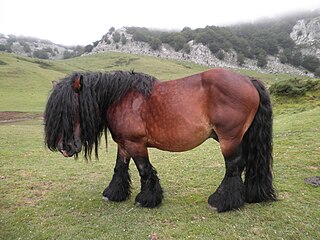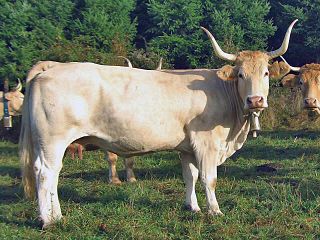
The Pottok or Pottoka, is an endangered, semi-feral breed of pony native to the Pyrenees of the Basque Country in France and Spain.

The Pita Pinta Asturiana is a Spanish breed of chicken. It is the only chicken breed indigenous to the principality of Asturias, in north-western Spain.

The Basque Shepherd Dog, Basque: Euskal Artzain Txakurra, Spanish: Perro de Pastor Vasco, is a traditional Spanish breed of sheepdog originating in the historic Basque Country. It is believed that they originated from Central European herding dogs.

The Pachón Navarro is a Spanish breed of hunting dog from the autonomous community of Navarre, in northern Spain. It is one of five Basque breeds of dog, the others being the Basque Shepherd Dog, the Erbi Txakur, the Villano de Las Encartaciones and the Villanuco de Las Encartaciones.

A sagardotegi is a type of cider house found in the Basque Country where Basque cider and traditional foods such as cod omelettes are served. Modern sagardotegis can broadly be described as a cross between a steakhouse and a cider house.

The Villano de Las Encartaciones is a Spanish breed of large working dog from the region of Las Encartaciones in the province of Biscay, in the Basque country; it is found also in Álava, in eastern Cantabria and in northern Burgos. The traditional use of the dogs is in management of the Monchina breed of cattle of Cantabria and the País Vasco, and particularly to assist with bringing the cattle down from the mountain pastures between October and December. In 2009 there were fewer than 200 dogs registered in the studbook.

The Burguete is a Spanish breed of horse from the autonomous community of Navarre in north-eastern Spain. It is listed in the Catálogo Oficial de Razas de Ganado de España in the group of autochthonous breeds in danger of extinction. It is reared principally for horsemeat. The name, both in Basque and in Spanish, is derived from that of the municipio of Auritz/Burguete.

The Jaca Navarra, or Navarrese Horse, is a Spanish breed of small horse from the autonomous community of Navarre in the north-eastern part of the country. In 2013 it was listed in the Catálogo Oficial de Razas de Ganado de España in the group of autochthonous breeds in danger of extinction. The total population of the Jaca Navarra has been variously estimated at 350, 250, and 240 and decreasing. In April 2011 the total population was reported to be 899, all of which were in Navarre. In 2000, and again in 2007, it was listed by the FAO as endangered.

The Basque Mountain Horse is a breed of horse from the Basque Country of Spain and France. It is listed in the Catálogo Oficial de Razas de Ganado de España, the official catalogue of livestock breeds of Spain, in the group of autochthonous breeds in danger of extinction. The original breed standard of the "Euskal Herriko Mendiko Zaldia / Caballo de Monte del País Vasco", officially approved on 21 July 1999 and published in the Boletín Oficial del País Vasco, the official bulletin of the Basque Country, was repealed in 2015 and replaced with a new one.

The Betizu is a breed of small mountain cattle which live in a semi-feral state in some mountainous parts of the Basque Country in both Spain and France. It is classified as an endangered breed by both the Ministerio de Agricultura, Pesca y Alimentación, the agriculture ministry of Spain, and by the Conservatoire des Races d'Aquitaine in France.
The business of livestock farming is prominent in the Basque Country (Spain). The climate of this region is ideal for raising cattle and other livestock and is classified as Atlantic, or warm and rainy. The most common breeds of livestock raised in this region include beef cattle, dairy cattle, sheep, goats, and horses. These animals are most often raised in mixed farms, or farms that contain a combination of these types of animals and not just one type exclusively. Although the number of livestock farms notably decreased between the years of 1999 and 2009, the number of animals raised on each remaining farm increased dramatically, as discussed in further detail below. In 2006, there were estimated to be about 19,000 Basque farms that involved the raising of livestock.

The Asno de las Encartaciones, Basque: Enkarterriko asto, is a breed of small domestic donkey from the western part of the autonomous community of the Basque Country, in north-east Spain. It is named for the comarca of Las Encartaciones (Enkarterri), in the province of Biscay (Bizkaia). It is the only small donkey breed of Spain, and resembles the Gascon donkey, now a sub-type of the Pyrenean donkey. The Asno de las Encartaciones is critically endangered, and is protected by conservation measures.

The Euskal Oiloa, Spanish: Gallina Vasca, is a breed of domestic chicken from the autonomous community of the Basque Country in north-eastern Spain and south-western France. It is the traditional rural chicken of the area, a rustic dual-purpose breed of Atlantic type, and differs from Mediterranean Spanish breeds such as the Castellana Negra and the Minorca in several respects: it has yellow legs and feet, red earlobes, and lays brown eggs.

The Pirenaica, Basque: Behi-gorri, is a breed of beef cattle indigenous to the Pyrenees of north-eastern Spain. It is distributed mainly in the autonomous communities of Navarre and the Basque Country, but is present in much of the northern part of the country. It is well adapted to the mountainous terrain and humid climate of the area. It came close to extinction in twentieth century, but is not now at risk.
The Villanuco de Las Encartaciones is a Spanish breed of small dog of ratter type. It originates in the comarca of Enkarterri in the Basque Autonomous Community in northern Spain. It is one of five Basque breeds of dog, the others being the Basque Shepherd Dog, the Erbi Txakur, the Pachón Navarro and the Villano de Las Encartaciones, and one of fourteen animal breeds native to the País Vasco.

The Monchina, Basque: Behi montxina, is a Spanish breed of mountain cattle indigenous to the autonomous communities of Cantabria and the Basque Country in northern Spain. It is related to the Betizu and possibly to the Terreña breeds of cattle of the Basque Country, and is closely associated with the Villano de las Encartaciones breed of dog, which is traditionally used in managing it. It is classified by the Ministerio de Agricultura, Pesca y Alimentación, the Spanish ministry of agriculture, as a "Raza Autóctona en Peligro de Extinción" or native breed at risk of extinction.

The Azpi Gorri is a traditional Basque breed of domestic goat. It originates in the historical Basque Country, and is the only recognised goat breed of that area. It is distributed in the northern part of the province of Álava and in southern Bizkaia, with a few herds in the autonomous community of Navarre.
The Euskal Antzara is a traditional Spanish breed of domestic goose. It originates in the historical Basque Country. It is the only recognised goose breed of that area, and one of two Spanish breeds of goose, the other being the Oca Empurdanesa. It is distributed mainly in the comarca of Enkarterri in the province of Bizkaia, particularly in the areas of Abanto, Balmaseda, Güeñes, Karrantza and Zalla.
The Erbi Txakur is a Spanish breed of scenthound. It originates in the provinces of Álava and Bizkaia in the Basque Autonomous Community in northern Spain. It is one of five Basque breeds of dog, the others being the Basque Shepherd Dog, the Pachón de Vitoria, the Villano de Las Encartaciones and the Villanuco de Las Encartaciones, and is one of fourteen animal breeds native to the Basque Country. It was traditionally used for hunting hare, but since the hare became scarce in the Basque country it is more frequently used to hunt wild boar, roe deer or occasionally foxes.























